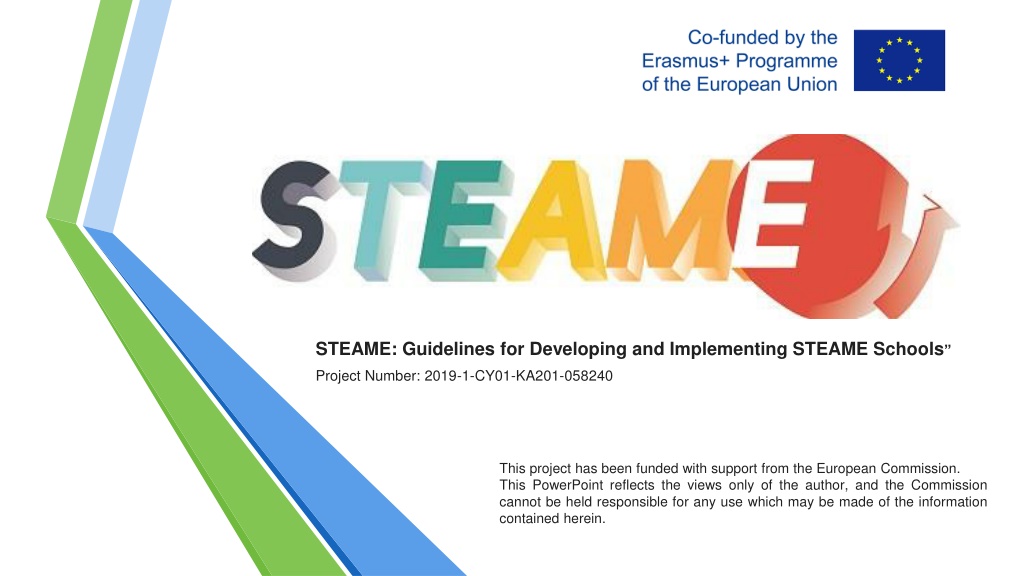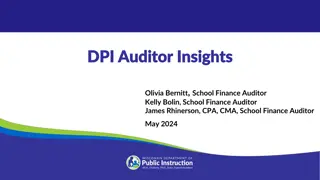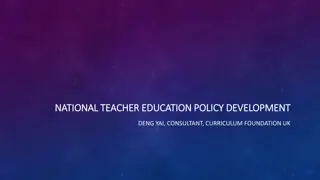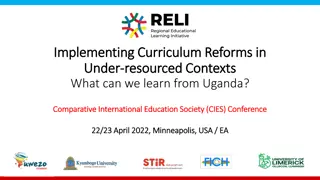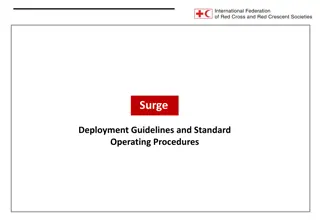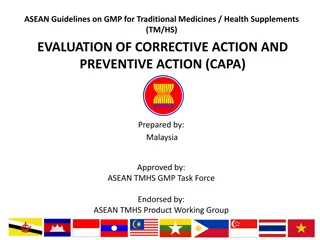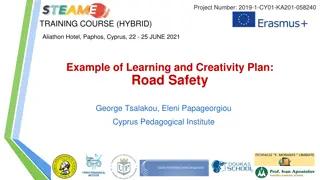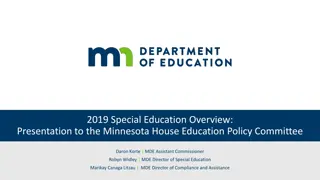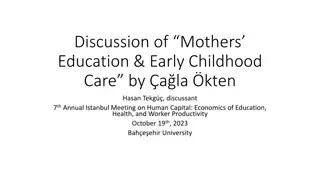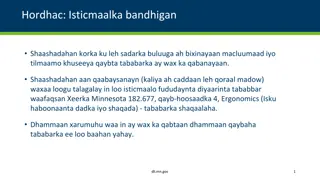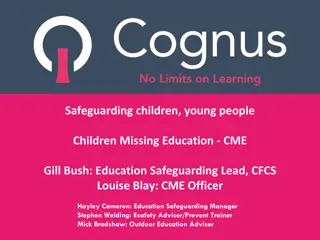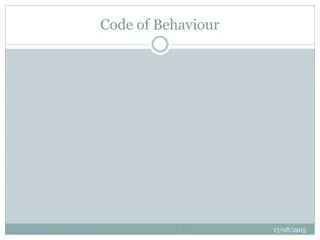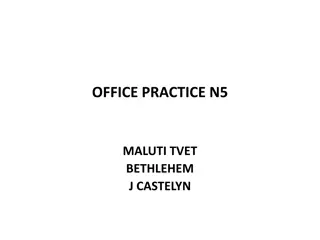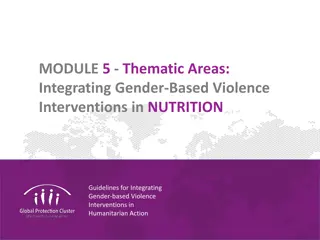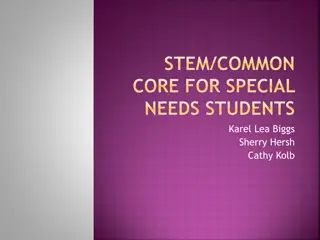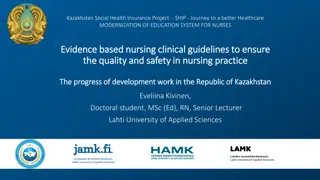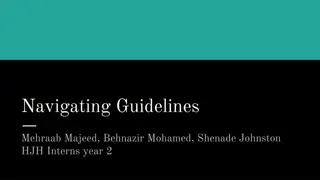Developing and Implementing STEAME Education Guidelines
Guidelines for developing and implementing STEAME education focus on connecting various realms of learning like Science, Technology, Engineering, Arts, Mathematics, and Entrepreneurship to the real world. This approach aims to facilitate the acquisition of knowledge, skills, values, morals, beliefs, and habits in individuals through collaborative learning methods. The importance of linking education with the environment and encouraging adaptability and change is emphasized. Teachers are encouraged to work together in promoting STEAME education to prepare learners for the demands of the modern world.
Download Presentation

Please find below an Image/Link to download the presentation.
The content on the website is provided AS IS for your information and personal use only. It may not be sold, licensed, or shared on other websites without obtaining consent from the author. Download presentation by click this link. If you encounter any issues during the download, it is possible that the publisher has removed the file from their server.
E N D
Presentation Transcript
STEAME: Guidelines for Developing and Implementing STEAME Schools Project Number: 2019-1-CY01-KA201-058240 This project has been funded with support from the European Commission. This PowerPoint reflects the views only of the author, and the Commission cannot be held responsible for any use which may be made of the information contained herein.
Training Program for Teachers or Others Interested in the Promotion/ Implementation of STEAME School Organizational Structure Module 3 How teachers work together? Gregory Makrides and Andreas Skotinos
Aristotle: The whole is more than the sum of its parts
Important Points that have to be taken into consideration: By definition STEAME education concerns a learning approach involving a variety of realms of meaning i.e. Science, Technology, Engineering, Arts, Mathematics and Entrepreneurship. The whole approach stems out from the need to connect education with the real world and not consider it as an isolated luxury that has been devised for just to be an added burden to human beings. STEMeducation stems out of the need to connect the realms of meaning and the real world. Moreover this need for connecting real world and education is reflected in one of the definitions of education:
Education is the process of facilitating learning, or the acquisition of knowledge, skills, values, morals, beliefs, and habits to individuals Then the question comes: For what purpose? In order to adapt to the environment (physical, socioeconomic, technological, cultural ) but also in order to become able to adjust/ amend/ change the environment in the context of the needs of the learner.
Consider the photo on the left What can you say about it? Do we have a kind of collaboration here? Can you identify a horse and a donkey? What is the offspring of such a collaboration? What are the characteristics of a horse and what are the ones of a donkey? What are the characteristics of a mule? So what is our conclusion?
Furthermore consider a hybrid car. What do these cars reflect as far as the collaboration of technology of powering cars using petrol and the technology of powering using electricity? What is the conclusion? What is the lesson we can get if we extend these ideas in the learning process as it relates to the needs of the real world in contrast to the traditional approach of teaching without taking into consideration the others, either teachers or entrepreneurs or whatever may be?
How teachers can work together? What is the range of this question? Teachers working with other teachers? Teachers working with other entities in the context of the school?(students, heads, parents ) Teachers working with experts in various fields? (Universities, Industry, NGOs, .) Teachers working with organisations that are promoting/ introducing to the world of life and work? (Factories, Businesses, Galleries, Museums ) What skills/ competencies do we expect from teachers in order to promote the idea of working together ? How do we develop/ encourage/ cultivate such skills/ competencies?
Quiz Before we move to the main question (of How can teachers work together?) let us reflect and consider some examples where we have issues that are interesting to both the real life and the school curriculum and where we are expecting collaboration of a broad range of expertise. The issues can range from technological needs to games and cultural activities Write down some of your suggestions In this process it is useful to identify: Topic of interest. Its relation to STEAME. Composition of Teams of collaboration and expected contribution from each member of the team. Associated Areas of the school curriculum.
Some Examples going further to the traditional approaches for project work
Example: A theatrical play: e.g. What is Infinity presented in the MATHeatrecompetition in the EUROMATH 2015 https://www.youtube.com/watch?v=0BtpDpa55u4&list=PLpPvt2LgHCYfT ulPlQkch1y7VW0I4ncje&index=8&t=301s It is an activity where a theatrical play is presented with STEAM content. For this a team of teachers from various disciplines are working together with students to present a play that provides motivation and explanations for concepts and processes. It is an excellent opportunity to combine the Arts with STEM. Careful consideration of the topic provides the forum for philosophical, cultural, foundational etc exploration of scientific, technological and mathematical processes in a pleasant and motivating environment.
Example: Tunnel of Eupalinos. The Ancient Samos and its water supply https://youtu.be/AJTwxCaOODM It is an activity where a problem that had to do with the watering of the city of Samos is becoming an issue of investigation by the students. One could refer to what ideas were developed 25 centuries ago and bring together engineers, environmentalists, mathematicians to consider solutions to everyday real world problems. Furthermore it provides another dimension in the STEAME approach, the one of taking ideas from historical events and adapt them to thee present .
Example: The Monopoly Game A game described and presented in the EU project MATH GAMES http://www.math-games.eu/index.php/en/ Monopoly is a game connecting Industry, mathematics and Business. It is a game referring to various kinds of STEAME activities. The students may be asked to provide extensions to extent the game to cover other issues as well, for example environmental issues and the need to introduce other dimensions in the game. By asking the students to proceed to activities with game character the teachers achieve quite a number of advantages for the learning process.
From the previous discussion it becomes clear that there is a need to bring teachers to develop competencies for working together. In this quest we can set the following objectives
The teachers should Be able to identify the major facilitators that have to be taken into consideration in determining and designing STEAME activities for students at secondary school level. Be able to specify their (the major facilitators) role and responsibilities. Be able to concentrate on the role and responsibilities of the sub-team of teachers that will be involved in the process of designing and implementing the STEAME activities. Be able to refer, to illustrate and to apply in class competencies for collaboration in order to promote actions and arrangements for preparing, formulating and implementing action plans for learning.
Such competencies include: Contact, cooperation and reflection with the workers shaping the real world. Provision of incentive and motivation to the learners. Determining and formulating, in cooperation with other facilitators, problems of interest to the real world Support and guide, in cooperation with other facilitators, the students for gathering information Support and guide, in cooperation with other facilitators, the students for handling a problem or project Support and guide, in cooperation with other facilitators, the students for using a variety of topics (in the context of STEAME) in developing and representing models for the promotion of solutions and results to the issues under consideration
Such competencies include: Support and guide, in cooperation with other facilitators, the students in developing creative and innovative approaches or models for the promotion of solutions and results to the issues under consideration. Assess cooperatively the work of the students and provide comments and suggestions taking into consideration the contribution of the various STEAME constituents. Review and reflect cooperatively (learners and learning facilitators).
Further more the teachers should be able to discuss and exchange ideas with other learning facilitators on Constructing learning plans with mutual content, complementing the aspects, concepts and processes that have common interest or value Assessing the various activities so that they have mutual value and Exploiting audiovisual and digital aids
In the context of the previous considerations and particularly in the context of the set of objectives mentioned earlier it is sensible to ask: What are some practical aspects that they should observe in order to achieve the goal of the present module ? i.e How do teachers can work together?
Two main Stages are suggested in this effort STAGE I: Preparation by one or more teachers plus experts/ entrepreneurs STAGE II: Action Plan of the involved teachers and students The latter Stage covering the following areas STAGE IIa: Action Plan Formulation (Steps 1-18) STAGE IIb: STEAME Actions and Cooperation in developing Creative Projects or other activities for school students STAGE IIc: Remarks-Guiding Lines for Collaborative Guidance
STAGE I: Preparation by one or more teachers plus experts/ entrepreneurs Formulating initial thoughts on the thematic sectors/areas to be covered Engaging the world of the wider environment / work / business / parents / society / environment/ ethics Target Age Group of Students -Associating with the Official Curriculum - Setting Goals and Objectives Organization of the tasks of the parties involved - Designation of Coordinator - Workplaces etc.
Some Actions that may be taken for stage I by the persons involved: Wider Environment/- Society plus the school staff Identify an issue, idea School Administration Teacher 1 Teacher 2 Teacher n Specify the aspects of the issue as they relate to the learning process, discuss possible thematic areas Propose ideas in related to his/hers subject area Propose ideas in related to his/hers subject area Propose ideas in related to his/hers subject area Step 1 of STAGE I
Some Actions that may be taken for stage I by the persons involved: Wider Environment/- Society plus the school staff Contact/ collaboration between the various actors to specify the various aspects, constituents of the problem School Administration Teacher 1 Teacher 2 Teacher n Step 2 of STAGE I Contact/ collaboration between the various actors to specify the various aspects, constituents of the problem Connect this to elements of the official curriculum Participate and elaborate on the discussions. Investigate on their repercussions on the curriculum of the topic in relation to the real world Participate and elaborate on the discussions. Investigate on their repercussions on the curriculum of the topic in relation to the real world Participate and elaborate on the discussions. Investigate on their repercussions on the curriculum of the topic in relation to the real world
Some Actions that may be taken for stage I by the persons involved: Wider Environment/- Society plus the school staff School Administration Teacher 1 Teacher 2 Teacher n Step 3 of STAGE I As specified in Step 2. Determine general objectives. Discuss responsibilities. Prepare initial plan Determine particular objectives and specify initial actions and needs. Exchange ideas with the other teachers Determine particular objectives and specify initial actions and needs. Exchange ideas with the other teachers Determine particular objectives and specify initial actions and needs. Exchange ideas with the other teachers
Some Actions that may be taken for stage I by the persons involved: Wider Environment/- Society plus the school staff Collaborate with the school and the teachers, in particular, on further actions ranging from support (economic ) to scientific School Administration Teacher 1 Teacher 2 Teacher n Step 4 of STAGE I Collaborate on management and organization issues Determine organizational and management issues and initial plan, through collaboration with the other teachers Determine organizational and management issues and initial plan, through collaboration with the other teachers Determine organizational and management issues and initial plan, through collaboration with the other teachers
STAGE IIa: Action Plan Formulation (Steps 1-18) Preparation (by the teachers involved) 1. Relation to the Real World Reflection 2. Incentive Motivation 3. Formulation of a problem (possibly in stages or phases) resulting from the above
STAGE IIa: Action Plan Formulation (Steps 1-18) Development (by students) Guidance & Evaluation (in 9-11, by teachers) 4. Background Creation - Search / Gather Information 5. Simplify the issue -Configure the problem with a limited number of requirements 6. Case Making -Designing -identifying materials for building / development / creation 7. Construction -Workflow - Implementation of projects 8. Observation-Experimentation -Initial Conclusions 9. Documentation -Searching Thematic Areas (STEAME fields) related to the subject under study Explanation based on Existing Theories and / or Empirical Results 10.Gathering of results / information based on points 7, 8, 9 11. First group presentation by students
STAGE IIa: Action Plan Formulation (Steps 1-18) Configuration & Results (by students) Guidance & Evaluation (by teachers) 12.Configure mathematics or other STEAME models to describe / represent / illustrate the results 13. Studying the results in 9 and drawing conclusions, using 12 14.Applications in Everyday Life - Suggestions for Developing 9 (Entrepreneurship -SIL)
STAGE IIa: Action Plan Formulation (Steps 1-18) Review (by teachers) 15.Review the problem and review it under more demanding conditions
STAGE IIa: Action Plan Formulation (Steps 1-18) Project Completion (by students) Guidance& Evaluation (by teachers) 16.Repeat steps 5 through 11 with additional or new requirements as formulated in 15 17. Investigation - Case Studies -Expansion -New Theories - Testing New Conclusions 18.Presentation of Conclusions -Communication Tactics.
STAGE IIb: STEAME Actions and Cooperation in developing Creative Projects or other activities for school students Brief Description/Outline of Organizational Arrangements / Responsibilities for Action
Phase Activities/Steps Teacher 1(T1) Cooperation with T2, Tn, and student guidance Activities /Steps Teacher 2 (T2) Cooperation with T1, Tn and student guidance Activities /Steps Teacher n (Tn) Cooperation with T1, T2 and student guidance Activities /Steps By Students Age Group: ____ Preparation of steps 1,2,3 Guidance in step 9 Cooperation in step 3 Cooperation in step 3 A Support guidance in step 9 Creative Evaluation Guidance Guidance Organization (SIL) STEAME in life Support guidance in step 9 Creative Evaluation Guidance Guidance Organization (SIL) STEAME in life 4,5,6,7,8,9,10 B Creative Evaluation Guidance Guidance Organization (SIL) STEAME in life 11 12 13 (9+12) 14 Meeting with Business representatives C D E F Preparation of step 15 Cooperation in step 15 Support Guidance Support Guidance Creative Evaluation Cooperation in step 15 G Guidance Guidance Creative Evaluation Support Guidance Support Guidance Creative Evaluation 16 (repetition 5-11) 17 18 H I K
So the question: What should be some aspects that collaborating teachers should have as lighthouse in the process of guidance?
STAGE IIc: Remarks and Guiding Lines for Collaborative Guidance Some Important Points that should be taken into consideration by the teachers collaborating in the process of guiding the students to take productive actions in the development of the project The official Curriculum. The activities and support should be focused in promoting the goals of the official curriculum as a whole and also as it is reflected in the individual curricula of the topics where the collaborating teachers are experts. Key Knowledge, Understanding and Success Skills. The project is focused on student learning goals, including standards-based content and skills such as critical thinking/problem solving, collaboration and self- management. Challenging Problem or Question.The project is framed by a meaningful problem to solve or a question to answer, at the appropriate level of challenge.
STAGE IIc: Remarks and Guiding Lines for Collaborative Guidance Some Important Points that should be taken into consideration by the teachers collaborating in the process of guiding the students to take productive actions in the development of the project Sustained Inquiry. Students engage in a rigorous, extended process of asking questions, finding resources and applying information. Authenticity. The project features real-world context, tasks and tools, quality standards or impact. Or it speaks to students personal concerns, interests and issues in their lives. Student Voice & Choice. Students make some decisions about the project, including how they work and what they create.
STAGE IIc: Remarks and Guiding Lines for Collaborative Guidance Some Important Points that should be taken into consideration by the teachers collaborating in the process of guiding the students to take productive actions in the development of the project Reflection. Students and teachers reflect on learning, the effectiveness of their inquiry and project activities, the quality of student work, obstacles and how to overcome them. Critique, Revision and Assessment. Students give, receive and use feedback to improve their process and products. Public Product. Students make their project work public by explaining, displaying and/or presenting it to people beyond the classroom
Consider the Learning and Creativity Plan so and so. What are the constituents/ structure of this Learning and Creativity Plan as it is presented in the Observatory? For this particular case identify, study, discuss and reflect on it, taking into consideration the points presented in the previous parts of this presentation i.ethe elements of Stage I and Stage II. Furthermore reflect on the extent/ degree that each of you feels that he/ she is in a position to develop their own Learning and Creativity Plans
Discussion and Reflection on the particular L&C plan Self-evaluation questionnaire for the trainees
1. Write on a piece of papers your suggestions for Tips for supporting/ facilitating/ enabling the collaboration/ working together of teachers in the context of STEAME 2. Provide support for your suggestions. 3. Discussion and Reflection
Some Tips for supporting/ facilitating/ enabling the collaboration/ working together of the teachers. Everyone should know what s expected of them and be made a valued part of the team. Everyone has unique skills and knowledge, so he/ she should be prompt to share those things with others. Working together on a lesson plan can be a great way to get to know your colleagues and to build better lessons for the students. Share experiences and what works or it is impressive and invite other teachers to share theirs through various means like blogs, social media, social networks etc A project that s too big to handle by one teacher is the perfect opportunity to pair with other teachers at the school.
Some Tips for supporting/ facilitating/ enabling the collaboration/ working together of the teachers. Get some feedback from students, parents, the school administrators, colleagues. Some schools schedule observations or videotape teachers, but even informal feedback can be beneficial. Schedule regular meetings, brainstorm, and get the comments, critiques and support of other teachers. Work with the others to overcome difficulties and solve problems. Make time for chatting, keep your door open and develop social mentality. Try co-teaching, visit and observe other classes, allow teachers to come to your class. Be open to new ideas, talk to the educational community. Contact the real world. Visit various experts and their facilities. Ask for ideas and support from the academic community.
Practicing collaboration of teachers in the context of STEAME Consider the participating list of trainees in this course taking into consideration there field area. Decide on a two or three topics that you feel that are suitable for developing activities in the context of STEAME with the collaboration of other teachers. Select from the participants list (preferably) or from the teachers in your school, one or two that you feel that they have common ground for working together on one of the topics you are thinking of.
Practicing collaboration of teachers in the context of STEAME Exchange ideas with them on the feasibility of collaboration on developing activities in the context of STEAME, proposing topics and initial steps for work. Continue this exchange of ideas and proposals until you reach to a point that you feel that you have enough ground of agreement and common understanding covering a topic, connection with the appropriate curricula etc, taking into consideration the list of tips suggested earlier. After reaching a consensus on the basic points start working for the preparation of a learning plan
Reflection and Assessment QUIZ What are the guiding principles for a successful preparation of a project or similar action requiring the involvement of more than one facilitator in the learning process in the context of STEAME? What are the important steps and actions that a team of teachers should undertake in order to design and process a learning plan in the context of STEAME?
Discussion Exchange of Ideas Remarks and Comments on the whole presentation
